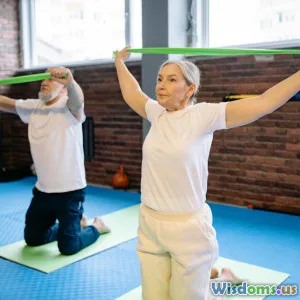
How Regular Exercise Reduces Chronic Disease in Elderly Populations
9 min read Explore how regular exercise combats chronic diseases, enhancing health and vitality in elderly populations with proven benefits and practical insights. (0 Reviews)
How Regular Exercise Reduces Chronic Disease in Elderly Populations
Aging is an inevitable journey filled with unique challenges, not least of which is the increased risk of chronic diseases. However, an empowering remedy stands accessible to many—regular exercise. Imagine adding years to your life while simultaneously enriching its quality. This is not a lofty promise but a scientifically-backed reality for elderly individuals who adopt regular physical activity.
Introduction: Defying Aging’s Chronic Challenges
Chronic diseases such as heart disease, diabetes, arthritis, and cognitive decline represent some of the most significant health hurdles the elderly face. According to the World Health Organization, chronic diseases account for approximately 70% of deaths worldwide, disproportionately affecting older adults. The persistent question remains: How can we mitigate this heavy burden?
The answer lies substantially in engaging the aging body through consistent exercise. Beyond just weight management or fitness maintenance, regular physical activity acts as a powerful intervention for disease prevention and symptom management among older adults. This article dissects the relationship between exercise and chronic disease reduction and unveils a practical approach rooted in science and expert insight.
Understanding Chronic Diseases in the Elderly
Chronic diseases that dominate elderly health statistics include cardiovascular diseases, type 2 diabetes, osteoarthritis, osteoporosis, and neurodegenerative disorders like Alzheimer’s. Their multifactorial origins often trace back to sedentary lifestyles, poor nutrition, and unavoidable biological aging.
Cardiovascular Disease
Heart-related illnesses comprise the leading cause of death among seniors. Blocked arteries, high blood pressure, and heart failure emerge prevalently, undermining quality of life dramatically. The Harvard T.H. Chan School of Public Health cites exercise as a cornerstone for lowering blood pressure by 5-7 mm Hg and reducing bad cholesterol (LDL) significantly.
Diabetes Mellitus Type 2
Ageing muscles tend to become insulin resistant, hindering glucose uptake and leading to elevated blood sugar levels. The Centers for Disease Control and Prevention (CDC) associates regular exercise with improved insulin sensitivity, reducing type 2 diabetes risk by up to 58%.
Arthritis and Osteoporosis
Joint pain and bone density loss often confine elderly people to inactivity, entrenching a vicious cycle of deterioration. Yet, studies published in the American Journal of Preventive Medicine emphasize that weight-bearing exercises slow bone loss and alleviate arthritic discomfort.
Cognitive Decline
Physical inactivity is linked to cognitive decline and dementia progression. The Alzheimer’s Association highlights that aerobic exercises enhance brain plasticity, boosting memory and executive functions.
How Exercise Mitigates Chronic Disease Risks
Physical activity modulates disease pathways by influencing multiple systems simultaneously. Here’s a comprehensive dissection of such mechanisms:
1. Cardiovascular Benefits
Regular exercise strengthens the heart muscle, improving its pumping efficiency. It enhances endothelial function — the capacity of blood vessels to dilate — which helps curb hypertension. For example, brisk walking for 30 minutes daily has been shown to decrease the risk of heart events by 30% in seniors, as documented by the American Heart Association.
2. Metabolic Regulation
Exercise activates glucose transporters in muscles without insulin, lowering blood glucose levels. Additionally, increasing muscle mass elevates basal metabolic rate, promoting better weight management and blood sugar control.
3. Musculoskeletal Health
Resistance and weight-bearing exercises stimulate osteoblasts, the cells responsible for bone formation, thereby preventing osteoporosis-related fractures. Controlled studies demonstrate that seniors performing thrice-weekly resistance training exhibit increased bone mineral density, fighting frailty effectively.
4. Inflammatory Response
Chronic inflammation underpins many chronic diseases. Physical activity downregulates pro-inflammatory cytokines like TNF-alpha and IL-6, decreasing systemic inflammation and related damage.
5. Mental Health and Cognitive Function
Aerobic exercise induces the release of brain-derived neurotrophic factor (BDNF), fostering neural growth and connectivity crucial for cognitive functions. In a landmark 2022 study published in the Journal of Alzheimer’s Disease, seniors engaging in physical activity showed slower cognitive decline rates.
Real-world Examples and Success Stories
The Blue Zones and Longevity
Populations in Blue Zones, geographical areas noted for their high life expectancy, consistently report moderate daily physical activity integrated into lifestyles. For instance, Okinawa’s elderly routinely engage in gardening and walking, practices aligned with their remarkably low chronic disease rates.
Clinical Interventions
The Lifestyle Interventions and Independence for Elders (LIFE) study provided compelling clinical evidence. Participants aged 70-89 who embraced moderate physical activity had 18% fewer major mobility disabilities and reduced cardiovascular risk after over two years compared to controls.
Practical Tips for Seniors to Incorporate Exercise
While enthusiasm is essential, structured guidance ensures safety and longest-lasting benefits.
Tailored Exercise Programs
Experts recommend a combination of aerobic (walking, swimming), strength training (resistance bands, lifting light weights), balance exercises (tai chi, yoga), and flexibility routines. Personalizing regimens based on medical conditions and physical capabilities is crucial.
Overcoming Barriers
Common obstacles such as fear of injury or lack of motivation often derail efforts. Community-based programs, social exercise groups, or tailored physiotherapy sessions provide supportive environments fostering adherence.
Monitoring Progress and Medical Clearance
Regular consultations with healthcare providers enable adaptation to evolving health statuses, ensuring exercise remains a safe and effective chronicle in managing chronic diseases.
Bringing It All Together: The Indispensable Role of Exercise
Exercise is more than a lifestyle choice; it is a medically validated tool that holds the key to reducing chronic disease burdens among elderly people. It energizes the cardiovascular system, balances metabolism, supports musculoskeletal integrity, assuages inflammation, and nurtures mental well-being.
The intersection of scientific evidence, enduring traditions from longevity hotspots, and global clinical trials converge on a singular truth: consistent physical activity can transform aging from a path beset by disability and illness into one marked by vigor and independence.
Conclusion: Empowering Aging Through Movement
The conversation around aging and chronic disease pivots on a compelling, hopeful theme—exercise is prevention, therapy, and lifestyle. Elderly populations wield the power to offset chronic conditions through simple, enjoyable, and sustainable physical activities, enhancing both their lifespan and healthspan.
Embracing movement today crafts a resilient, vital tomorrow, proving that age, while inevitable, does not dictate the quality or quantity of life. As the medical community increasingly underscores, the prescription for elderly health might just begin with a walk, a stretch, or a set of carefully performed exercises.
References
- World Health Organization, 2021. "Global status report on noncommunicable diseases."
- American Heart Association, 2019. "Physical Activity and Cardiovascular Health."
- Centers for Disease Control, 2020. "Exercise and Type 2 Diabetes Prevention."
- Alzheimer’s Association, 2022. "Exercise and Brain Health."
- LIFE Study, 2019. "Effect of Physical Activity on Mobility Disability in Older Adults."
- Buettner D., 2012. "The Blue Zones: Lessons for Living Longer From the People Who've Lived the Longest."
Rate the Post
User Reviews
Popular Posts

















